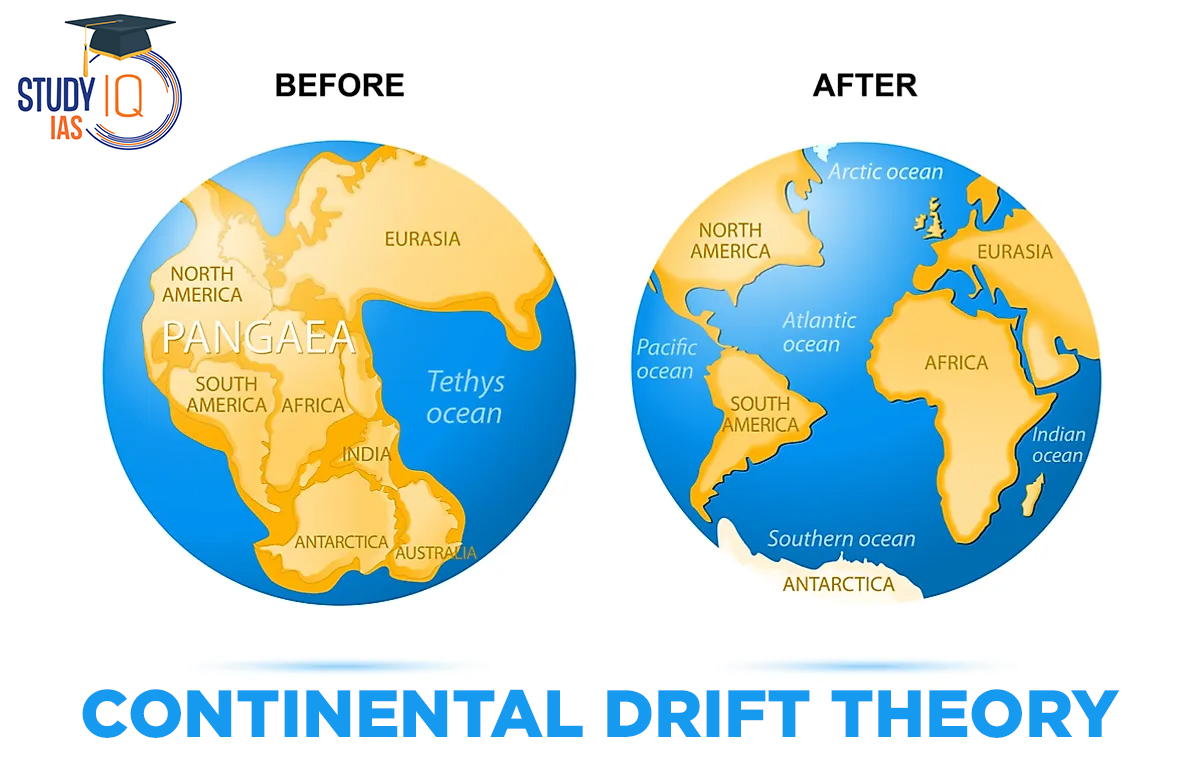Table of Contents
Continental Drift Theory by Alfred Wegener
Alfred Wegener proposed the Continental Drift theory in 1912. It was first suggested by Abraham Ortelius in 1596, and Alfred Wegener completed its development in the early 1900s. The hypothesis addresses how the continents and oceans are distributed. According to Wegener’s hypothesis of continental drift, Pangaea, a Mega Ocean surrounding a supercontinent that consisted of all the continents as a single continental mass known as a Super Continent. Panthalassa is another name for the Mega Ocean.
Pangaea: Wegener believed that all continents were once joined together in a supercontinent called Pangaea, which existed about 240 million years ago. It began to break apart around 200 million years ago.
Evidence for Pangaea:
Fossils: Fossils of the same freshwater reptile, Mesosaurus, were found in both Africa and South America, suggesting they were once connected.
Plant Fossils: Fossils of tropical plants were found in cold regions like Svalbard, indicating those areas once had a warmer climate.
Rock Structures: The coastlines of South America and Africa fit together like a puzzle, and their rock layers matched as well.
Tectonic Activity: Wegener’s theory lacked a clear explanation for how continents moved. Today, we understand that continents sit on large pieces of rock called tectonic plates, which are constantly moving.
Modern Movement:
Seafloor Spreading: New ocean floor is created at mid-ocean ridges, causing continents to move apart. For example, the North American and Eurasian plates are separating at about 2.5 cm (1 inch) per year.
Rift Valleys: Areas like the Great Rift Valley in Africa are where land is pulling apart, which could eventually split the continent.
The concepts of seafloor spreading, rift valleys, and subduction were better understood in the 1960s, explaining the movements Wegener observed. Today, scientists believe multiple supercontinents have formed and broken apart over Earth’s history.
Continental Drift Theory for UPSC: Various Stages
First Stage
A mega-ocean called Panthalassa ringed the supercontinent Pangea during the Carboniferous period’s first stage.
Second Stage
The supercontinent Pangaea began to break apart around 200 million years ago during the Jurassic period. It first split into two large parts: the northern part was called Laurasia, and the southern part was called Gondwanaland.
Third Stage
During the Mesozoic era’s third stage, the Tethys Sea steadily widened and filled the space between Laurasia and Gondwanaland.
Fourth Stage
The Atlantic Ocean first appeared in the fourth stage, some 100 million years ago, when North and South America moved westward. The westward movement of North and South America resulted in the formation of the Rockies and Andes.
Orogenetic Stage
The fifth stage is the Orogenetic Stage, during which mountain-building activity occurred.
Forces Responsible for Continental Drift
The Earth is not a perfect sphere, it has a bulge at the equator. This shape along with gravity forces that push away from the poles, and buoyancy, contributed to the movement of continents toward the equator. Also, tidal currents caused by the Earth’s rotation also pushed the continents westward. However, it was later determined that these factors alone could not fully explain continental drift leading to criticism of Wegener’s theory.
Objective about Continental Drift Theory
In 1912, German scientist Alfred Wegener proposed the idea of continental drift. He explained his theory in a book called “Die Entstehung der Kontinente und Ozeane,” published in 1922 and translated into English in 1924. Wegener wanted to explain major climate changes that have happened in Earth’s history, like the Carboniferous Glaciation. He believed these climate changes could be caused in two ways:
- Climate zones could shift while the continents stayed in the same place.
- The continents could move while the climate zones stayed the same.
Wegener preferred the second idea, suggesting that the movement of continents affected the climate.
Other Theories related to Formation of Continents
Most scientists agree that the movement of tectonic plates causes continents to form. Earth’s surface is made up of solid slabs called tectonic plates, which makes it different from the moon. While both planets show recent changes on their surfaces, the moon does not have plates. As technology improved, scientists found strong evidence for the ideas of continental drift and seafloor spreading. Today, these two theories are combined into the modern theory of plate tectonics.
Evidences Supporting Continental Drift Theory
The Matching of Continents (Jig-Saw-Fit)
The coastlines of South America and Africa look like they fit together when you place them side by side. Similarly, Africa, Madagascar, and the east coast of India also fit together in a way that suggests they were once connected.
Rocks of Same Age across the Oceans
Scientists use radiometric dating to study how rocks on different continents are related. For example, the mountain ranges in Western Africa match old rocks that are about 2 billion years old off the coast of Brazil. The Caledonian mountains in Scotland and the Appalachian mountains in the United States also have similarities. This research shows that the early marine deposits along the coasts of Africa and South America formed during the Jurassic period, meaning the ocean wasn’t there before that time.
Tillite
The sedimentary rock known as tillite was produced by glacial deposits. Six separate landmasses in the Southern Hemisphere, including Africa, the Falkland Islands, Madagascar, Antarctica, Australia, and India have been found to have analogies to the Gondwana system of deposits from India. It demonstrates that these land masses had a remarkably similar history in antiquity.
Placer Deposits
Along the coast of Ghana in West Africa, there are gold deposits found in the sand and gravel. However, there is no nearby source rock where the gold could have come from. Interestingly, it’s possible that the gold veins exist in Brazil. When you put Ghana and Brazil next to each other, it seems like the gold in Ghana may have come from the Brazil plateau.
Distribution of Fossils
On each side of the sea barrier, the same kinds of species and animals may be found. For instance, only Southern Africa and Eastern South America are home to Mesosaurus, a freshwater crocodile-like reptile that lived between 286 and 258 million years ago.
Limitations of Continental Drift Theory
Wegener was unable to clarify why the drift started during the Mesozoic epoch. According to Wegner, the forces that propelled the movement of continents were buoyancy, tidal currents, and gravity, but these forces are too weak to move continents. Pangaea is acknowledged by contemporary ideas (Plate Tectonics), although the explanation disproves Wegner’s theory of drifting.
His explanation of how the SIAL (Silica-Aluminum)-based continental crust, which is floating over the SIMA (Silica-Magnesium)-based ocean floor, formed island arcs that, according to him, were formed during the drifting of continents as a result of friction, fell short. Later Plate Tectonic Theory demonstrated that the entirety of SIAL and SIMA is floating over the asthenosphere.
Other Indian Geography Topics
Other Fundamental Geography Topics


 Story of Meera Bai and Her Devotion For ...
Story of Meera Bai and Her Devotion For ...
 Desert Climate, Distribution, Climatic C...
Desert Climate, Distribution, Climatic C...
 Deserts of India Map, Features of Thar D...
Deserts of India Map, Features of Thar D...





















